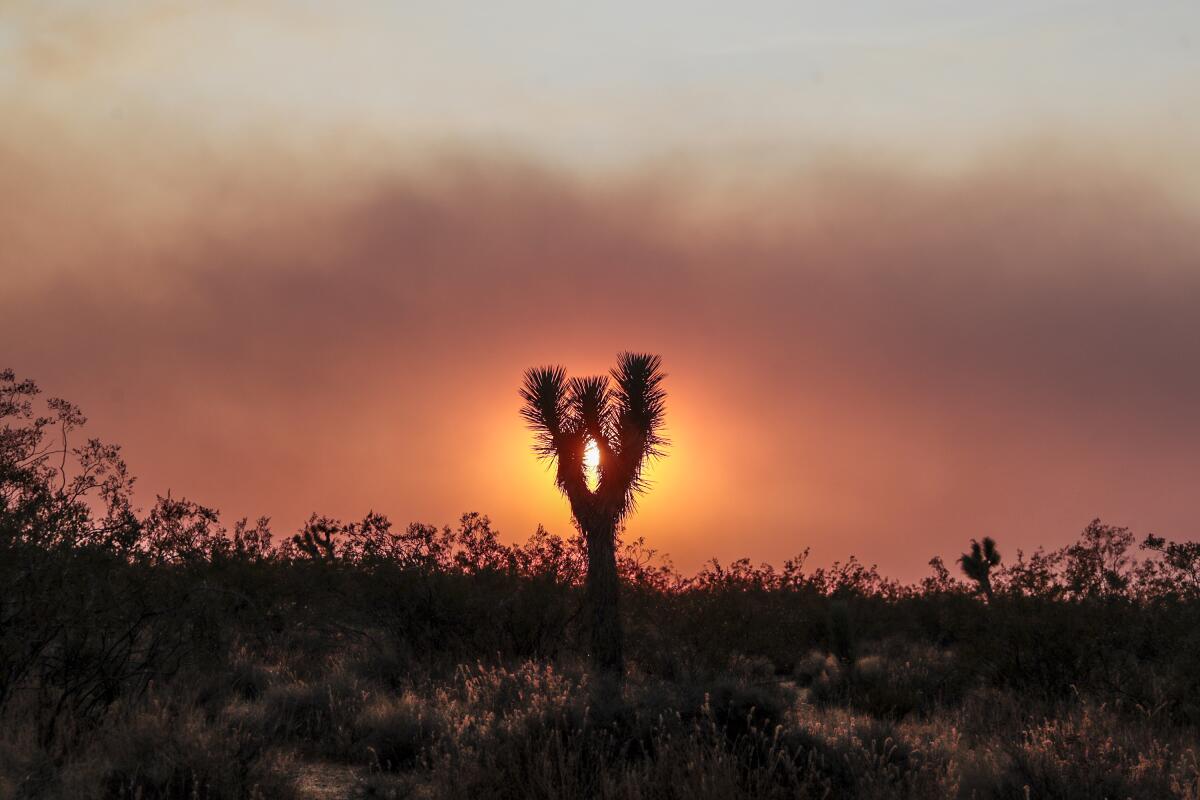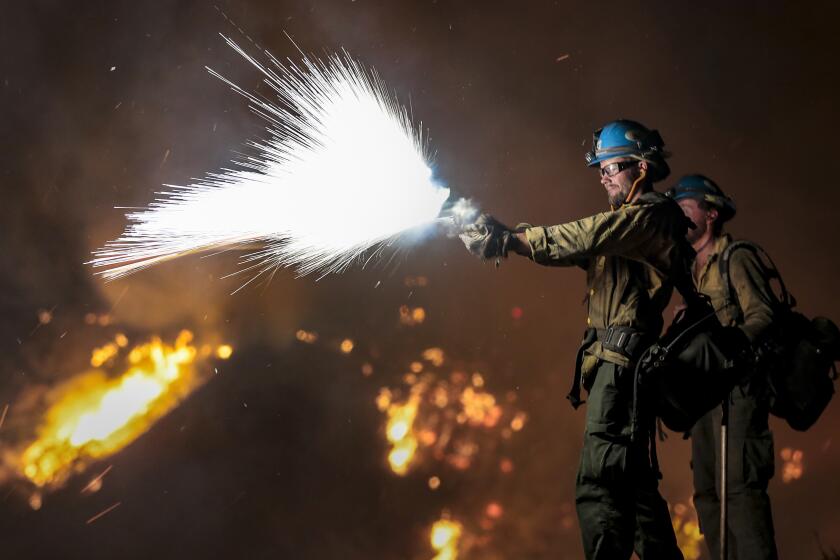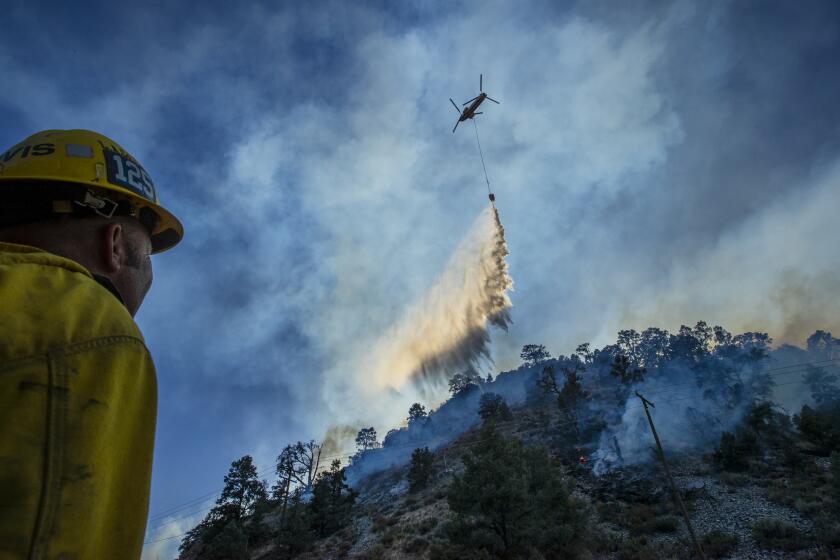Bobcat fire burns 112,000 acres and at least 29 structures, and is only 17% contained

Fire officials say the number of burned structures could rise as high as 85 as the blaze continues to grow.
- Share via
At least 29 structures have been destroyed by the Bobcat fire in northeastern Los Angeles County, and the number could reach 85, officials said Tuesday.
The U.S. Forest Service, one of the agencies fighting the blaze, said Tuesday evening that the voracious fire has expanded to more than 112,000 acres and is just 17% contained.
“It’s a very dynamic incident,” Los Angeles County Fire Chief Daryl Osby said in a virtual community meeting Monday evening. “This is Day 16 of the Bobcat incident. I am humbled for the people who have lost homes or property.”
Fears of a significant spread of the Bobcat fire dissipated as Santa Ana winds failed to materialize, but foothill communities remain on high alert.
The Antelope Valley communities of Cima Mesa, Juniper Hills, Pearblossom and Devil’s Punchbowl likely bore the brunt of structure losses, officials said, but they couldn’t immediately confirm how many of the burned structures are homes. An assessment team will move through the area to provide an updated count.
One structure confirmed to have been damaged is the nature center at the Devil’s Punchbowl Natural Area, a 1,310-acre rock canyon that receives a reported 130,000 visitors each year. The Los Angeles County Department of Parks & Recreation tweeted Saturday that no animals or staff were injured in the fire and that the staff office at the wildlife sanctuary survived.
The fire’s containment numbers dipped to 13% Monday evening but had climbed back to 17% by Tuesday, thanks to progress along the eastern edge of the blaze off the Highway 39 corridor, according to U.S. Forest Service public information officer Andrew Mitchell.
But fire crews had a setback Tuesday as personnel numbers dropped from 1,700 to 1,500 — something Mitchell attributed to required rest days for beleaguered personnel.
“We’re only allowed to work 14 days straight before we have to take a mandatory two days off,” he said. “You’ll probably see the number grow back in the next couple of days.”
The remaining crews have been divided by the fire’s multidirectional growth, which includes a northward creep into Antelope Valley and a “hard push” southwest toward the famed Mt. Wilson Observatory.
“Mt. Wilson is definitely critical,” Mitchell said Tuesday. “It’s something that we’re really putting a lot of effort into today.”
The Forest Service said the fire’s encroachment on the mountaintop was because of “unfavorable” wind conditions as well as patches of dry fuels, such as conifer trees.
Lower temperatures and higher humidity levels Tuesday helped tamp down some of the fire’s activity, officials said in an update Tuesday evening, but they predicted that conditions would become hotter and drier overnight.
They warned of a “a significant warming and drying trend” beginning this weekend, along with a chance of “gusty northeast winds” that could affect fire conditions.
Overnight aerial video showed flames approaching the communications towers at the top of the mountain, which are reportedly valued at $1 billion and provide frequencies for television and radio channels, including KPCC, KTLA and KNBC.
Mitchell said at least one spot fire has broken out at Mt. Harvard, a nearby hillside with additional communications infrastructure, but it was quickly contained by fire crews.
In San Bernardino County, meanwhile, an honor guard Tuesday morning carried the body of a firefighter who died battling another blaze, the El Dorado Fire, from the county coroner’s office to a mortuary in Orange County. Charles Morton, a 14-year veteran who led the Big Bear Interagency Hotshots, died Sept. 17. He was 39.
As a motorcade escorted his body from San Bernardino to Ferrara Colonial Mortuary in Orange, fire crews lined up along the route, some standing atop their engines, to salute the procession.
Morton is survived by his wife, daughter, parents and two brothers.

Evacuation orders remain in place for several communities in the Angeles National Forest and the foothills north of the blaze. Evacuation warnings also remain for Pasadena, Altadena and other areas threatened by the fire.
New evacuations were ordered Monday afternoon near Colby Ranch and Hidden Springs.
An American Red Cross evacuation point has been set up at Palmdale High School in the Antelope Valley. Red Cross spokeswoman Marilyn Jimenez Davila said 190 individuals have used the evacuation point and disaster distress hotline to receive hot water, meals and hotel accommodations.
Smoke advisories related to the Bobcat fire and the El Dorado fire in San Bernardino County have been extended through Tuesday, according to the South Coast Air Quality Management District, which noted that the Bobcat fire is “producing substantial amounts of smoke.”
The Bobcat fire is moving into some remote areas in the Antelope Valley, destroying homes and prompting numerous evacuations, officials said.
With Tuesday marking the first day of fall, Mitchell said officials hope lower temperatures and increased humidity will arrive at some point to help contain the spread of the blaze — but the National Weather Service is forecasting more warm and dry conditions for the day.
“We are in extreme conditions right now,” fire behavior analyst Patrick Doyle said during the virtual community meeting Monday. “It’s very dry out. ... Fire danger indices right now are very high.”
Speaking at a news conference Monday, Gov. Gavin Newsom said an estimated 6,400 structures have burned in California this year — the most destructive wildfire season on record. Newsom said estimates of the wildfires’ damage are based only on what crews have seen so far.
“By no stretch of the imagination do we think this tells the entire story,” he said. “As we get back in, and people are able to repopulate and go back into their communities, we will determine more structure loss.”
More to Read
Sign up for Essential California
The most important California stories and recommendations in your inbox every morning.
You may occasionally receive promotional content from the Los Angeles Times.
















